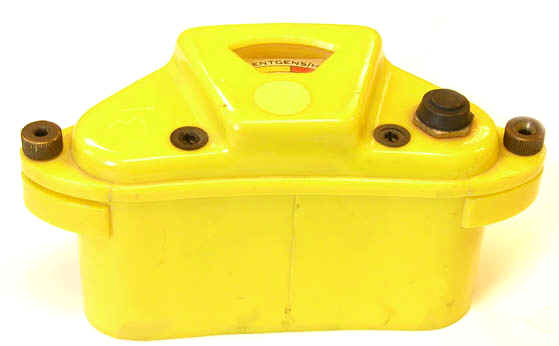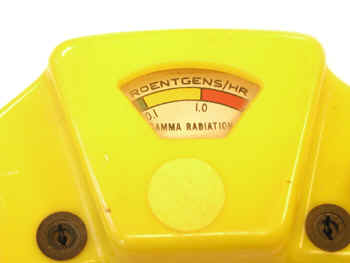The LeVine Meter (1950s)
The LeVine Meter was a relatively high range civil defense meter for civilian use that employed a halogen quenched GM tube as the detector. Normally a GM tube would not be used in a high-end instrument because the tube would be prone to saturation. However, this is not a problem if the detector operates in the current mode (i.e., the circuit integrates the charge) rather than the more usual pulse mode. A vibrator type transformer (similar to an induction coil) is used to step up the high voltage. This design seems to have been the inspiration for the military’s AN/PDR-32 Radiac.
While it has the characteristic yellow color of the CDV civil defense instruments, the LeVine meter actually predates them by several years.


The display is a crude non-linear scale divided into three ranges: green, yellow, and red. Just like a traffic light. The boundaries between the three ranges were 0.1 and 1.0 R/h.
It was developed at the Instruments Branch of the Atomic Energy Commission's New York Operations Office and described for the first time in the June 1950 issue of Nucleonics. In this publication, three different versions of the meter were illustrated but none looked like the one pictured above.
The version shown here seems to be a slightly later version and probably dates from 1951. This particular example was donated to the collection by FEMA and was identified as a proposed citizens meter (ca. 1960). Perhaps one reason that the design was never adopted was its lack of precision—it simply gave a go/no go type of response. CDV instruments were intended to provide more quantitative information than that.
It is named after one of its developers, Harris (Harry) LeVine. For what it is worth, the "v" in the latter's name is usually, but not always, capitalized. Sometime in the 1960s, LeVine's home in New Jersey became contaminated with americium-241.
Range: 0-1 + R/h non-linear scale
Size of case: ca. 3” x 7” x 3.5”
Batteries: Two 1.5 volt “D” cells
Donated by the Federal Emergency Management Agency courtesy of Carl Siebentritt.
References
- LeVine, H.D. and H.J. DiGiovanni, “An Inexpensive, Wide Range Gamma Ray Geiger Survey Meter, NYO-1538, January 1951.
- LeVine, H.D., DiGiovanni, H.H. and Coe, M.R., "Geiger Counter for Civilian Defense Use." Nucleonics, June 1950, p. 56-59.
- Morgan, K.Z., “Health Control and Nuclear Research”, unpublished manuscript, (in several places, the text refers to the "current date" as being 1951).
